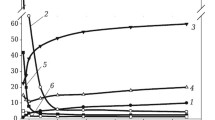Abstract
The possibility of using an aqueous emulsion of cutting liquid waste in the production of construction ceramics is determined. The effect of CL waste on the structural and flow (molding) properties and the energy consumed in the molding of clay and ceramic mixtures based on Kiev spondyl clay is studied.
Similar content being viewed by others
References
A. A. Krupa and V. S. Gorodov,Chemical Engineering of Ceramic Materials [in Russian], Vishcha Shkola, Kiev (1990).
S. P. Nichiporenko,Physicochemical Mechanics of Disperse Structures in Structural Ceramics Technology [in Russian], Naukova Dumka, Kiev (1968).
A. F. Bykhova, S. P. Nichiporenko, and V. V. Khil’ko,On Selecting a Technology for Ceramic Mixture Production [in Russian], Naukova Dumka, Kiev (1980).
A. A. Krupa and V. S. Paleichuk, “Coagulation structure formation and drying of materials modified by chemical reactants,”Ukr. Khim. Zh., No. 12, 1094–1096 (1992).
Author information
Authors and Affiliations
Additional information
Translated from Steklo i Keramika, No. 9, pp. 15–17, September, 1999.
Rights and permissions
About this article
Cite this article
Paleichuk, V.S., Krupa, V.A. & Tkach, V.V. Control of structural and flow properties of ceramic mixtures using aqueous emulsion of cutting liquid waste. Glass Ceram 56, 281–283 (1999). https://doi.org/10.1007/BF02681376
Issue Date:
DOI: https://doi.org/10.1007/BF02681376




